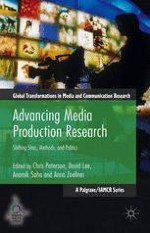2016 | Buch
Advancing Media Production Research
Shifting Sites, Methods, and Politics
herausgegeben von: Chris Paterson, David Lee, Anamik Saha, Anna Zoellner
Verlag: Palgrave Macmillan UK
Buchreihe : Global Transformations in Media and Communication Research - A Palgrave and IAMCR Series
